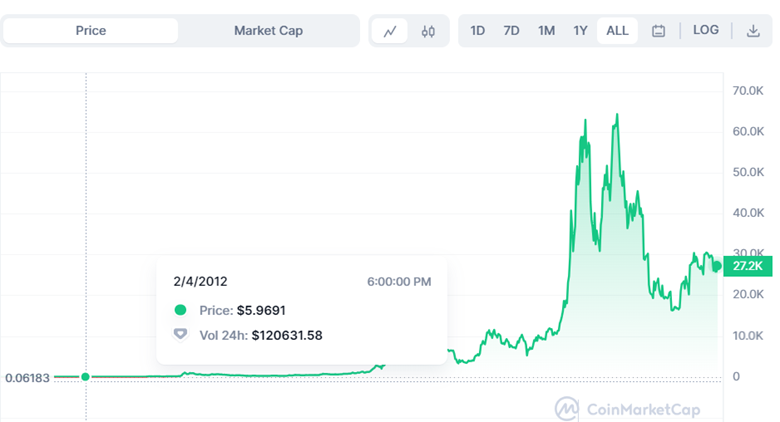Originally coined to address discrepancies in the value of metal coins, Gresham’s Law is increasingly pertinent not just to contemporary fiat currency markets but also to the dynamic world of cryptocurrencies.
Decoding Gresham’s Law
In the 16th century, Sir Thomas Gresham delved into the public’s response to the devaluation of currency in England, leading to the principle known as Gresham’s Law. It articulates the economic concept that “inferior currency displaces superior currency” within a financial ecosystem. The case in point: England's silver shillings, which were devalued by being mixed with less valuable metals. Consequently, the pure silver coins, although legally equated to the same value as the debased ones, were seen as more valuable due to their metal content.
Motivated by self-interest, individuals circulated the less valuable coins for daily transactions and hoarded the full silver shillings, which were undervalued in terms of their legal tender but overvalued in their metal worth. This behavior effectively reduced the number of silver shillings in active circulation.
The Broad Impact of Gresham’s Law According to Sir Thomas Gresham
Gresham’s insights into the debasement of the shilling revealed a larger economic issue: the separation between the face value of money and its underlying worth. This divergence gave rise to a secondary market for the silver-rich shillings. While Gresham wasn’t the initial observer of this economic behavior, his detailed analysis was so influential that economist Henry Macleod later named the principle after him in the 19th century. Notably, the roots of Gresham’s Law reach back to the works of Greek philosopher Aristophanes and are also echoed in ancient texts like the Talmud and the Bible.
Gresham’s Law describes how 'bad money drives out good money' within an economy, leading to the superior currency being hoarded and the inferior being circulated.
Gresham’s Law in the 20th Century and Beyond: Currency Debasement's Legacy
In transitioning from the 16th century to the 20th century, the evolution of currency and its role in transactions and wealth preservation witnessed significant changes. The concept of coin debasement, as illustrated by English shillings, extends beyond this historical period. Before 1965, U.S. quarters and dimes contained 90% silver, but their silver content was phased out. This prompted Americans to hoard silver coinage while utilizing debased coins for everyday purchases, echoing a pattern observed in England four centuries prior. Legal tender laws have historically enforced parity in value between new, less valuable coins and older ones.
Today, physical coinage plays a diminishing role in U.S. commerce, primarily serving as change for infrequent cash transactions. The transformation of U.S. dollars (USD) is notable, as they were once represented by gold certificates exchangeable for physical gold. However, this changed when President Nixon closed the gold window, preventing foreign governments from redeeming USD for gold. These historical examples underline the inflationary consequences associated with currency debasement in accordance with Gresham's Law. This principle holds true, whether it pertains to metallic coinage, physical cash, or any other form of currency or medium utilized in transactions and value exchange. (Further insights on this topic will be explored below.)
Gresham’s Law and Its Application to Fiat Currency
As we step into the 2020s, the era of metallic currency, particularly those backed by gold or silver, has largely faded in many nations. However, the timeless adage, "bad money drives out good," extends beyond physical coins; it applies to the intricate realm of global currency markets. Just as coins of the same face value but different metal content are evaluated and compared, people engage in similar assessments when it comes to fiat currencies.
Travelers who've journeyed with physical cash, particularly in regions like Southeast Asia or Central/South America, may have noticed a preference for accepting the US Dollar (USD) over local currencies. The rationale lies in the USD being considered a "superior currency" compared to many other fiat options, as it experiences a slower rate of debasement. The issuance of fiat currency allows governments to create more currency at will, often resulting in persistent inflation as the norm for most economies.
When a nation's currency undergoes rapid devaluation, it prompts residents to seek more stable foreign currencies. In some scenarios, we witness a phenomenon akin to "good money driving out bad money," which is the inverse of Gresham's Law, also known as Thiers' Law. When legal tender regulations lack stringent enforcement, superior or stronger currencies take precedence. In such cases, individuals may opt to transact only in a foreign currency like the US Dollar, refusing the local currency. Alternatively, adhering to Gresham's Law, they may retain the stronger currency (e.g., USD) while using the weaker one for daily transactions, a scenario notably observed in Zimbabwe during the 2010s.

Gresham’s Law and Hyperinflation: The Struggle to Preserve Wealth
Many nations strive to encourage their citizens to use their own national currencies. To achieve this, governments often employ regulations and policies aimed at discouraging or prohibiting the use of alternative fiat currencies. These measures encompass currency controls, capital controls, government-mandated exchange rates for fiat, and even the confiscation of precious metals owned by citizens. Enforcing these rules requires the imposition of penalties, which can be substantial, including hefty fines and lengthy prison sentences.
Nevertheless, even the most severe penalties can't always dissuade individuals from seeking refuge from the wealth-depleting effects of hyperinflation. During economic crises and the chaos accompanying near-worthless currencies, governments sometimes struggle to enforce currency laws that a significant portion of the population can no longer reasonably adhere to. Notable examples of hyperinflation include the Weimar Republic in the 1920s, Hungary in the mid-1940s and Zimbabwe in the late 2000s, where inflation reached extreme levels. Although the Weimar Republic is one of the most famous examples of hyperinflation, with prices doubling every 4 days other instances of hyperinflation were even more extreme, with prices doubling every 15 hours in Hungary and every day in Zimbabwe at the height of their respective crises. Currently, Argentina faces significant inflation, exceeding 100%, with projections suggesting it may surpass 160% by year-end. In times of substantial inflation and hyperinflation, citizens seek ways to convert their money into assets that can preserve value.

Gresham’s Law, the USD, and Dollarization: Safeguarding Wealth in Hyperinflation
In recent hyperinflationary crises, like the ongoing situation in Venezuela since 2016, many locals have sought to convert their own currency into the US Dollar (USD). Despite stringent regulations designed to prevent this, citizens often go to great lengths to preserve their financial assets. This phenomenon is known as dollarization, wherein the local currency becomes secondary, and USD takes its place as the primary medium of exchange. Dollarization can be either legally endorsed through national legislation (with 11 countries already adopting the USD as an official currency) or exist informally as a widely accepted, though not universally embraced, de facto currency.
While concerns arise regarding global de-dollarization, the prevalence of dollarization serves as a robust indicator that the USD remains a dominant force in the world economy. However, it's worth noting that the USD, as mentioned earlier, has already severed its ties to gold or silver, retaining one key advantage: its slower rate of debasement compared to other fiat currencies, primarily due to measures like quantitative easing or "money printing."
Gresham’s Law, Bitcoin, and the Rise of Cryptocurrencies
While the US Dollar (USD) remains a satisfactory choice for most people and purposes, an increasing number of pragmatic individuals seek alternatives to hedge their financial portfolios. For some, that alternative is gold, but for others, the allure of "better money" resides within the realm of blockchain technology. Enter cryptocurrencies, tokens, or digital assets—innovative options engineered to mitigate the risk of value debasement.
Among these digital assets, the pioneer is Bitcoin (BTC), distinguished by its fixed supply of 21 million BTC. Regardless of the demand for BTC, this quantity cannot be augmented, a feature designed to safeguard against monetary debasement. The market has responded positively to this scarcity, as reflected in its substantial value (as shown below).

Bitcoin (BTC) is just one of many cryptocurrencies designed to fulfill one or more of the fundamental functions of currency: serving as a unit of account, a medium of exchange, and a store of value. However, BTC currently holds the reins as the dominant cryptocurrency, constituting approximately half of the entire digital asset market, which exceeds a trillion dollars in total capitalization.
Beyond Bitcoin's prominence, the cryptocurrency ecosystem offers a multitude of innovative options designed to serve as reliable stores of value while mitigating the notorious price volatility associated with BTC's upward trends. These alternative cryptocurrencies, often referred to as buoyant stablecoins or flatcoins, are engineered to align with inflation in a consistent and predictable manner. Unlike traditional fiat-pegged stablecoins, which merely mirror the value of USD, EUR, or other commodities like gold, buoyant stablecoins offer a unique approach to preserving wealth.
Cryptocurrency and the Future of Money: Resisting Debasement
The consensus, particularly among Austrian economists, asserts that currency debasement contributes to inflation. As a result, proponents of sound money seek to diversify their assets to protect against debasement's wealth-eroding consequences. This inclination is why many experts predict that Bitcoin (BTC) and select digital assets will continue to appreciate in value over the long term.
Beyond their value as investments, cryptocurrencies like Bitcoin also function as robust payment infrastructures. They facilitate the seamless movement and transfer of bitcoin (the asset) on decentralized financial systems—a significant but often overlooked aspect of their value.
Moreover, the nature of BTC and other cryptocurrencies makes them challenging for governments to confiscate, unlike bank account balances or precious metals. This resistance to confiscation underscores their appeal as a means of preserving wealth.
While numerous cryptocurrencies compete for market share, much like fiat currencies vying against the US Dollar, it's important to note that not all blockchain-based tokens aim to replace fiat currencies. Many cryptocurrencies have distinct use cases, which extend beyond the scope of this article.
For crypto investors residing in regions with relatively low fiat-denominated inflation, there's still a strong incentive to invest in cryptocurrencies. However, the allure is even greater for those in regions grappling with severe inflation. This persistent economic challenge serves as a powerful driver for crypto adoption, especially as many countries show no signs of improving their monetary practices. In Argentina, for instance, presidential candidate Javier Milei has been elucidating the debasement of the Argentinian peso and advocating for both dollarization and crypto adoption as solutions to combat the country's economy-damaging inflation.
Whether or not these solutions are implemented, Argentinians share a common goal: preserving their wealth. They will explore various avenues, including acquiring USD, cryptocurrencies, and other hard assets, regardless of the legal landscape. In 2021, El Salvador notably made BTC legal tender, potentially setting a precedent. If more countries follow suit, it could have a positive long-term impact on crypto investors with exposure to blockchain-based fiat currency alternatives.
Navigating the complex and ever-changing world of digital assets can be a challenge, but staying informed is key. If you found value in these insights and wish to deepen your understanding of this evolving space, consider connecting with CKC.Fund on LinkedIn. Additionally, if you aren’t already, you can subscribe to our newsletter, filled with tailored digital asset insights. For more personalized guidance, reach out at info@ckc.fund. Connecting with us helps you stay one step ahead in the world of digital assets.
This content is intended for general informational purposes only. CKC.Fund does not render or offer personalized financial, investment, tax, legal, security, or accounting advice. The information provided in this content is provided solely as general information and to provide general education. No information contained herein should be regarded as a suggestion to engage in or refrain from any investment-related course of action. This content may contain certain statements, estimates and projections that are "forward-looking statements." All statements other than statements of historical fact in this content are forward-looking statements and include statements and assumptions relating to: plans and objectives of management for future operations or economic performance; conclusions and projections about current and future economic and political trends and conditions; and projected financial results and results of operations. These statements can generally be identified by the use of forward-looking terminology including "may," "believe," "will," "expect," "anticipate," "estimate," "continue", "rankings," “intend,” “outlook,” “potential,” or other similar words. CKC.Fund does not make any guarantees, representations or warranties (express or implied) about the accuracy of such forward-looking statements. Forward-looking statements involve certain risks, uncertainties, and assumptions and other factors that are difficult to predict. Viewers are cautioned that actual results referenced in this content could differ materially from forward-looking statements; and viewers of this content are cautioned not to view forward-looking statements as actual results or place undue reliance on forward-looking statements. Past performance is not indicative nor a guarantee of future results. No content in this content shall be viewed as a guarantee of future performance.

